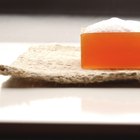Silly string is a party and holiday favorite. Otherwise known as string in a can, silly string is ideal for decorating your home quickly and easily for any occasion. It comes in many colors. Silly string is basically an aerosol liquid that becomes tacky when sprayed. Unfortunately, not much is known about silly string, other than it is not flammable, that it is free from CFCs and it is almost entirely nontoxic, (check out the Resources section for more information on why the full ingredients are not disclosed). Actually, the ingredients are not even listed on cans of silly string that can be purchased in stores. While we have found out what some of the ingredients are and can guess at others, only the true manufacturers of this product know exactly what goes into making it. With that being said, this article is going to give you the basic idea of how to make silly string.
The resin is the basis of the silly string. It is the plastic component of the string, and is what makes silly string have the physicality that it has. You need to have the right amount of resin to get silly string to work. Too much resin will make the final product too thick, and not enough resin will make it too liquidized, and it won’t be able to form into string. Despite the resin being so important, it only makes up 10 or 15 percent of the total mix.
A surfactant, or surface active agent, is important, as this is what causes the resin to foam and expand–without this, the silly string would not be able to form. The surfactant makes up less than 5 percent of the total mix; so using 3 to 4 percent surfactant will give you the proper amount. Again, you need to have just the right amount of surface active agent. Too little surfactant will make the strands of silly string too sticky, and it wouldn’t come away from surfaces it comes into contact with. Too much of the surface active agent will make the texture too much like a hair mousse or shaving foam, which is not good.
The majority of what goes into the can of silly string is actually propellant, which is what forces the mixture to come out of the can and become silly string. It does this by causing a reaction between the surface active agent and the resin. The contents of your silly string can also be fine-tuned by a few different touches. These include adding a plasticizer, which depending on how much is added, makes the strands of string stronger and less sticky. Silicone liquid will also make the string less sticky and easier to clean up. Adding a flame retardant is important as this will make the mixture safer.
Related Articles

What Are Sugar Crystals?

Ingredients of Fels Naptha

Aveda Shampure Ingredients

Ingredients in Dial Liquid Soap

How to Make All-Natural Hand Sanitizer

Properties of Bentonite Magmas

Do Eggs Make Baked Goods Rise?

Main Ingredients in Cologne

Adding Cream of Tartar to Macaroons

Noxzema Ingredients

Ingredients of Bar Soap

What Is the Difference Between 9K & 14K ...

Corn Starch Vs. Baking Powder in Cooking

What Is 916 in Jewelry?

Merle Norman Ingredients

What Are the Different Types of Gold ...

How to Make Homemade Liquid Rouge

How to Make a Pumpkin Spice Cappuccino
How to Make Frosting Bubbles for a ...

Can You Make Dumplings With Corn Starch?